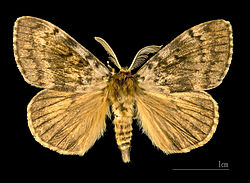| Lymantria dispar | |
|---|---|
 | |
| Mounted Lymantria dispar dispar male | |
 | |
| Mounted Lymantria dispar dispar female | |
| Scientific classification | |
| Kingdom: | Animalia |
| Phylum: | Arthropoda |
| Class: | Insecta |
| Order: | Lepidoptera |
| Superfamily: | Noctuoidea |
| Family: | Erebidae |
| Genus: | Lymantria |
| Species: | L. dispar |
| Binomial name | |
| Lymantria dispar | |
| Subspecies | |
| Synonyms | |
| |

Lymantria dispar, also known as the gypsy moth [2] [3] or the spongy moth, [4] [5] is a species of moth in the family Erebidae native to Europe and Asia. Lymantria dispar is subdivided into several subspecies, with subspecies such as L. d. dispar and L. d. japonica being clearly identifiable without ambiguity. Lymantria dispar has been introduced to several continents and is now additionally found as an invasive species in Africa, North America and South America. The polyphagous larvae live on a variety of deciduous and coniferous trees [6] and can cause severe damage in years of mass reproduction. Due to these features, Lymantria dispar is listed among the world's 100 worst invasive alien species. [7]
